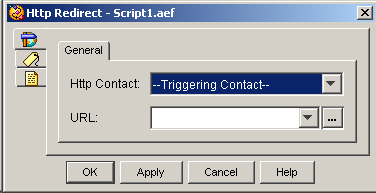Http Redirect Step
Use the Http Redirect step to redirect the browser to go to a specified URL instead of responding directly to an HTTP or HTTPS request.
You can, for example, use this step to redirect the browser to a different server.
A script should use only one of the following steps from the Http Contact palette to respond to an HTTP or HTTPS request:
-
Http Redirect
-
HTTP Forward
-
Send Http Response
If you use the Http Redirect step, you should not use either a HTTP Forward or Send Response step in the same sequence within a script, because using any one of these three steps moves the Http Contact into a final state when the response is returned back to the browser. The script cannot attempt to send another response back because one has already been sent. If, however, a script has some conditional logic, you can use one of these three steps in one condition and another in another condition.
Note | You can also use the Reject and Terminate steps from the Contact palette as responses to an HTTP or HTTPS request. For more information, see Contact Steps. |
Figure shows the customizer window for the Http Redirect step.

The following table describes the properties of the Http Redirect customizer window.
|
Property |
Description |
|---|---|
|
Http Contact |
Contact that triggers the execution of the step. Default is Triggering Contact, unless another contact is specified. |
|
URL |
Supports HTTP and HTTPS triggers. Variable containing—or an expression resolving to—a URL to which the browser is redirected. |